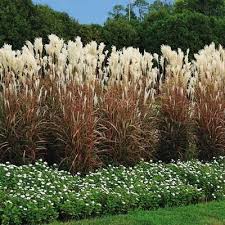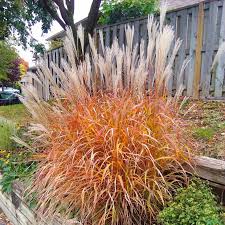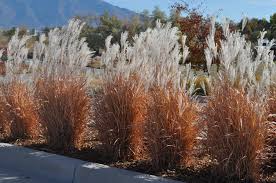Flame Grass, also known by its scientific name Miscanthus sinensis ‘Purpurascens,’ is a truly remarkable and wonderful plant that can bring a special touch of beauty to gardens and outdoor spaces. This plant has a special kind of grass that grows in a unique way, and it has leaves that change color as the seasons go by. Let’s take a closer look at this amazing Flame Grass!
When you see Flame Grass, you might notice that its leaves are really special. At first, they start off as a fresh green color in the springtime. As the days get warmer and longer, something magical happens: the leaves begin to turn shades of red and orange, almost like the colors of a warm and cozy fire. This is why it’s called “Flame Grass” – because it looks like it has flames dancing on its leaves.
Taking care of Flame Grass is not too hard, which is really nice for people who might not be expert gardeners. It likes sunlight a lot, so putting it in a place where it can soak up the sun’s rays is a good idea. But it’s also okay with a bit of shade. Just like people, Flame Grass needs water to grow, especially when it’s new and getting settled in the ground. After a while, though, it gets used to the place it’s in and can handle not having too much water.
During the summer and fall, Flame Grass puts up tall stems that have fluffy parts on top. These fluffy parts are kind of like feathers and can look really pretty when they move with the breeze. Birds and insects sometimes find these fluffy parts a great place to rest or look for food, which is pretty cool because Flame Grass helps create a little home for them in the garden.
When it gets colder and winter comes, the leaves of Flame Grass start to dry up and turn a little brown. But even though they might look different, they still add a nice touch to the garden. Some people choose to cut back the dried leaves in the spring, but you don’t have to if you like the way they look. It’s like a natural decoration that stays in your garden even when the weather gets chilly.
Additionally, Flame Grass is like a magical friend for your garden. It brings color and life in the warmer months and stays around to remind you of its beauty when it’s colder. With its easygoing nature and the way it changes colors, Flame Grass can truly make your garden feel like a special place all year long. So, if you’re looking for a plant that’s both easy to take care of and a joy to watch, Flame Grass might be just the right choice for you.
Read Also: Problems of Post-Harvest Fish Activities and its Management Procedures
Growing Flame Grass

Below is a comprehensive growing guide for Flame Grass (Miscanthus sinensis ‘Purpurascens’).
1. Choosing the Right Spot: Flame Grass loves the sunlight, so try to plant it in an area where it can get at least 6 hours of direct sunlight each day. However, it’s also adaptable to some shade, so if your garden has a mix of sun and shade, Flame Grass can still thrive.
2. Soil Preparation: Prepare the soil by digging a hole that’s about twice the width of the plant’s root ball. Flame Grass can grow in a variety of soil types, but well-drained soil is ideal. If your soil is heavy and doesn’t drain well, you might want to mix in some compost or sand to improve drainage.
3. Planting: Place the Flame Grass in the hole you’ve prepared and backfill with soil, gently pressing down to eliminate any air pockets. Water the plant thoroughly after planting to help it settle into its new home.
4. Watering: In the beginning, Flame Grass needs regular watering to establish its root system. Water deeply once a week, especially during the first growing season. As it becomes more established, it can tolerate periods of drought, but be sure to water during extended dry spells.
5. Fertilizing: You don’t need to fertilize Flame Grass excessively. A light application of balanced fertilizer in the spring, as new growth starts to emerge, should be sufficient. Avoid over-fertilizing, as this can cause the plant to become too lush and floppy.
6. Pruning: Flame Grass has a wonderful feature in its dried foliage, so you might want to leave it in place during the winter for added interest. In early spring, around late February or March, you can cut back the old foliage to about 6 inches from the ground. This makes way for new growth to emerge.
7. Dividing: Over time, Flame Grass can grow quite large. If you notice the center of the plant becoming less vigorous or the clump becoming too big, it might be time to divide it. The best time to do this is in early spring, just as new growth is beginning. Dig up the entire clump, divide it into smaller sections using a sharp shovel or knife, and replant the divisions.
8. Pests and Diseases: Flame Grass is relatively resistant to pests and diseases. Keep an eye out for any signs of damage, such as chewed leaves or discoloration. If you spot any issues, treat them promptly with appropriate solutions.
9. Winter Care: In colder regions, Flame Grass can die back completely in the winter. You can leave the dried foliage in place to provide some protection for the crown of the plant. If you prefer a tidier look, you can cut back the dead foliage in late winter or early spring before new growth emerges.
Remember, gardening is a learning experience, and each garden has its unique conditions. Observing your Flame Grass and making adjustments based on its growth and needs will help you create a thriving and beautiful outdoor space. Enjoy the process of nurturing your Flame Grass and watching it transform your garden throughout the seasons.
Caring for Flame Grass

Certainly, here’s a comprehensive caring guide for Flame Grass (Miscanthus sinensis ‘Purpurascens’) to help you keep your plant healthy and thriving:
1. Watering
Establishment Phase: Water regularly after planting to help the roots establish. Keep the soil consistently moist but not waterlogged.
Mature Plants: Once established, Flame Grass is fairly drought-tolerant. Water deeply during dry periods, allowing the soil to dry out between waterings.
2. Sunlight
Full Sun: Flame Grass thrives in full sun, receiving at least 6 hours of direct sunlight per day. However, it can tolerate some light shade.
3. Soil
Well-Drained Soil: Plant Flame Grass in well-draining soil. If your soil retains too much water, consider amending it with compost to improve drainage.
4. Fertilizing
Spring Feeding: Apply a balanced, slow-release fertilizer in early spring as new growth emerges. Avoid excessive fertilization, as it can lead to floppy growth.
5. Mulching
Mulch Application: Apply a layer of organic mulch around the base of the plant in early spring to help retain soil moisture and control weed growth.
6. Pruning
Spring Cleanup: In late winter or early spring, cut back the old foliage to about 6 inches above the ground to make way for new growth.
Deadheading: Remove faded or spent flower plumes in late winter or early spring before new growth appears.
7. Dividing
Division: Divide mature clumps every 3 to 4 years in early spring to rejuvenate the plant and maintain its vigor.
Replanting: Replant the divisions in well-prepared soil, ensuring they have enough space to grow.
8. Pests and Diseases
Inspect Regularly: Keep an eye out for pests like aphids, spider mites, and grasshoppers. Monitor for signs of diseases such as rust or fungal infections.
Prompt Action: If you notice any issues, treat with appropriate insecticides or fungicides as needed.
9. Winter Care: Winter Protection In colder climates, the dried foliage can provide some protection to the crown of the plant during winter. You can choose to leave it in place or cut it back before new growth emerges.
10. Landscape Use
Versatile Plant:Flame Grass can be used as a striking focal point, in group plantings, or as a border plant to add texture and color to your landscape.
Combination Planting: Consider pairing Flame Grass with other plants that complement its colors and growth habit.
11. General Tips
Observation: Regularly observe your Flame Grass for any changes in growth, color, or health. Adjust your care routine based on its needs.
Maintenance: Keep the area around Flame Grass weed-free and clear of debris to promote healthy growth.
Remember, gardening is a learning experience, and each plant has its unique preferences. By following this caring guide and getting to know your Flame Grass, you’ll create an environment where it can flourish and bring beauty to your garden throughout the seasons.
Read Also: Management Strategies and Uses in Fisheries Management
Uses of Flame Grass

Flame Grass (Miscanthus sinensis ‘Purpurascens’) offers several wonderful uses in landscaping and gardening:
1. Visual Focal Point: Flame Grass serves as an eye-catching focal point in gardens and landscapes. Its tall, arching stems and vibrant foliage create a dynamic presence that draws attention and adds a touch of drama. Planted as a single specimen or in small groups, Flame Grass can anchor the design of your garden, providing a stunning visual element that changes with the seasons.
2. Textural Contrast and Structure: The feathery plumes and graceful arching growth habit of Flame Grass create a captivating contrast to other plants in the garden. Its texture and movement bring a sense of softness and elegance, balancing out the more rigid forms of shrubs and trees. When planted in masses or along borders, Flame Grass adds structure to the landscape, guiding the eye and creating a sense of rhythm and flow.
3. Wildlife Habitat and Winter Interest: Flame Grass offers a dual benefit to wildlife and garden enthusiasts alike. During the fall and winter months, the dried plumes and foliage of Flame Grass provide shelter and food for birds and insects. Birds might use the stems and plumes for nesting material, while insects find refuge among the grass blades. This creates a mini-ecosystem in your garden, fostering biodiversity and supporting local wildlife.
Additionally, the persistent foliage and interesting texture of Flame Grass continue to be appealing even after it goes dormant in colder months. The bronze and copper tones of the dried foliage add warmth and beauty to the winter landscape, creating a lovely backdrop for other winter-interest plants or garden decorations.
In summary, Flame Grass is a versatile plant with multiple uses that extend beyond its visual appeal. Whether it’s commanding attention as a focal point, enhancing the garden’s texture and structure, or providing habitat for wildlife, Flame Grass brings a sense of enchantment and functionality to outdoor spaces.
Read Also: How to Recycle and Repurpose Plastic Items for Reuse
